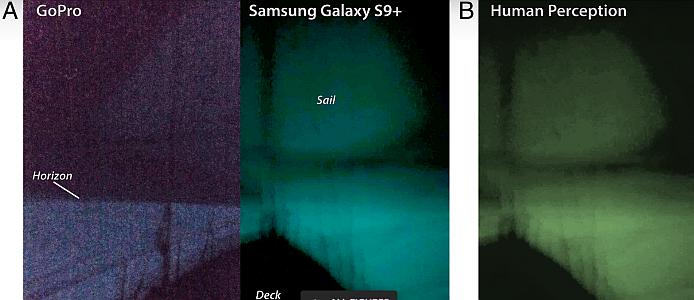
Digital photography of the 2019 Java milky sea, captured by Ganesha’s crew, showing a view of (A) the ship’s prow and (B) a color-adjusted to human perception
For thousands of years, sailors have told of nighttime seas that mysteriously glowed a milky white or luminescent blue, stretching out to the horizon. Referred to as a “milky sea,” the tales date back at least to Greece and Roman times and may have provided inspiration for the “ocean of milk” from Hindu mythology.
As with so many sea stories, the challenge for scientists has been to document and study what sailors had observed far from land in remote stretches of the world’s oceans.
Now, scientists using light-sensing satellites have been able to track milky sea luminescence. And by happenstance, they now have sea level confirmation of their observations from a private sailing yacht that happened to find itself sailing in a glowing sea that coincided with the satellite observations.
At the ocean’s surface, bioluminescence comes in two general types. The common one arises when churning waves or other movements stimulate microorganisms to glow. Many a nighttime beachgoer has seen the blue-green luminescence in breaking waves.
The other type — the kind that creates a milky sea — is poorly understood and appears to exist free of mechanical stimulation.
Recently, scientists discovered that milky sea ocean bioluminescence can be so intense and massive in scale that satellites orbiting five hundred miles high can see glowing mats of microorganisms as they materialize in the seas. Last summer, in the journal Scientific Reports, eight investigators, led by Dr. Steven D. Miller, a satellite expert at Colorado State University, told of finding a luminous patch south of Java in 2019 that grew to be larger than the combined areas of Vermont, New Hampshire, Massachusetts, Rhode Island, and Connecticut, as reported by the New York Times.
Coincidentally, Naomi McKinnon, a crew member on the SY Ganesha, a 52-foot-long ketch sailing south of the Indonesian island of Java on a moonless night in 2019, was shocked to find the sea glowing white when she came on deck.
“What the hell?” she recalled thinking.
What Ms. McKinnon and her six crewmates encountered in August 2019 was a swell of glowing seawater so bright and gargantuan in size that a satellite orbiting hundreds of miles overhead was able to see its shimmers. McKinnon and the Ganesha‘s crew recorded their position, photographed the luminescence, and collected buckets of seawater.
Late last year, after Ms. McKinnon learned of Dr. Miller’s research, she came forward, reluctantly. “I thought, ‘Maybe he doesn’t want to know,’” she recalled. “But his response was ‘Wow! You’re the first person to confirm this!’ He was so excited. I was really glad I reached out.”
Dr. Miller told of the sailboat’s corroboration of the spacecraft observations in the Proceedings of the National Academy of Sciences.
Dr. Miller said the observations by Ms. McKinnon and crew offer insights on a major enigma — how tiny organisms can influence whole seas.
“It’s one big coupled system,” Dr. Miller said of ocean currents and the atmosphere. “It’s important for us to understand how this basic level of the biosphere ties into that.”
